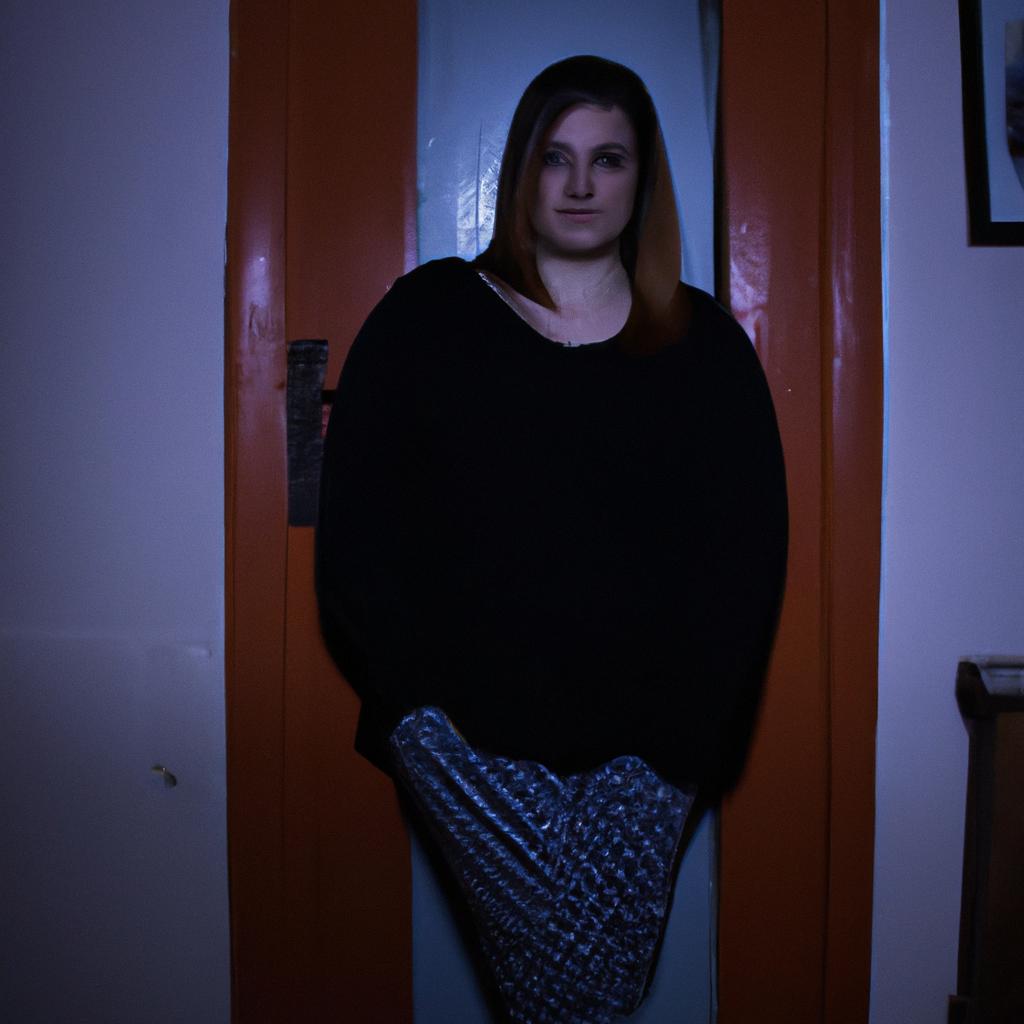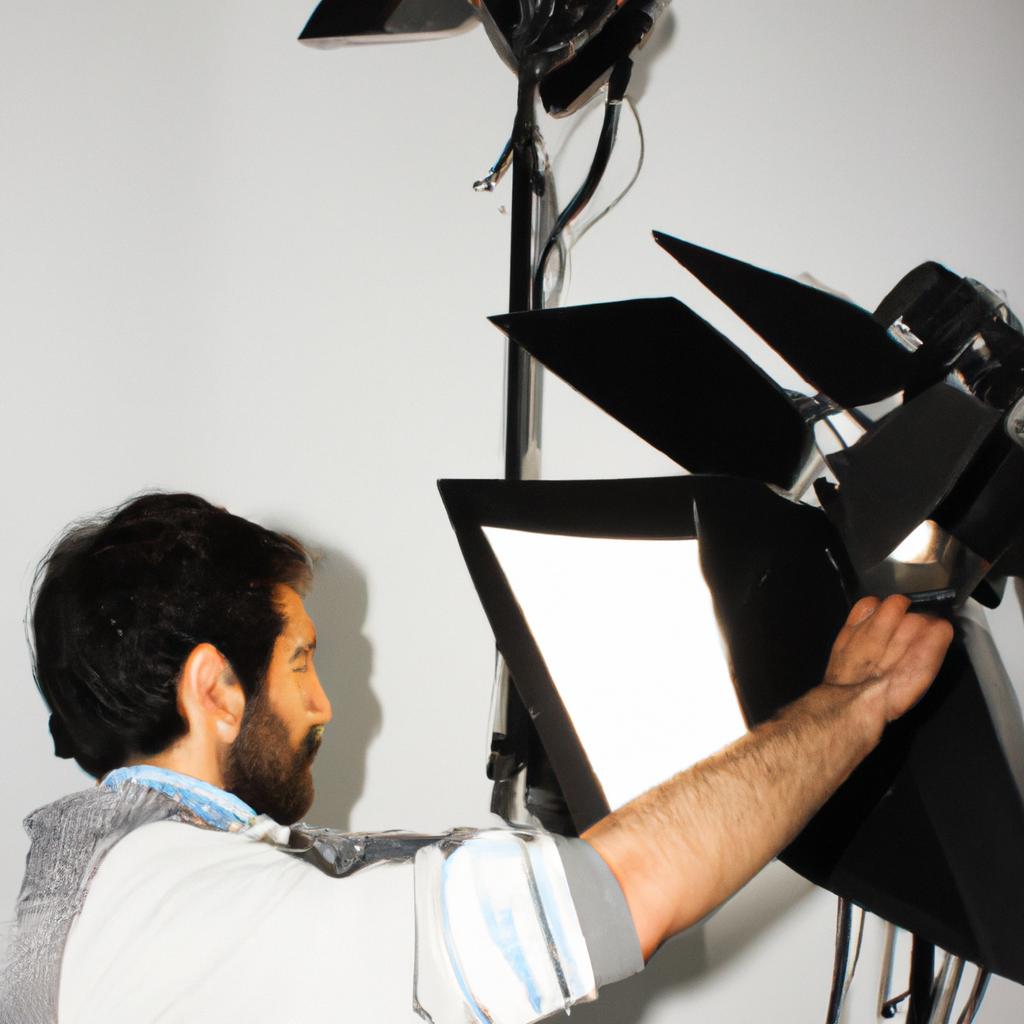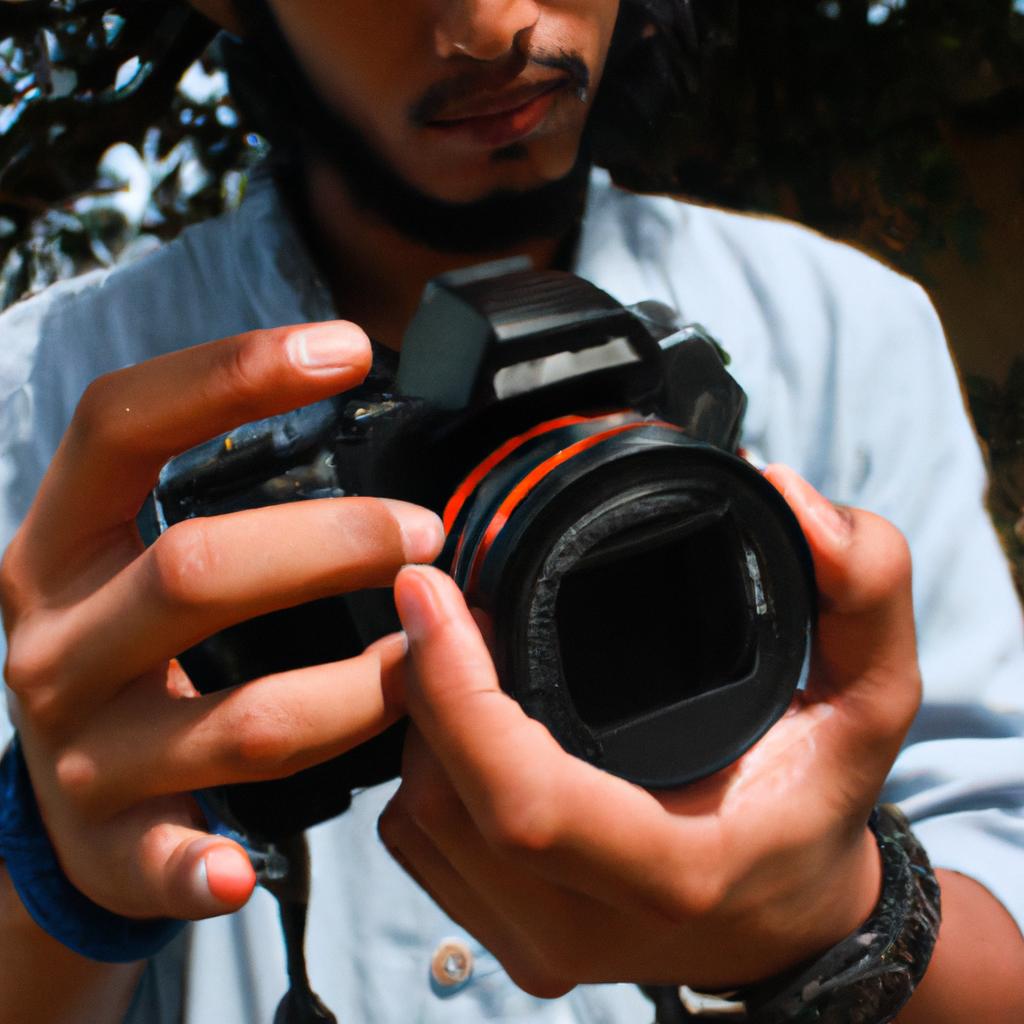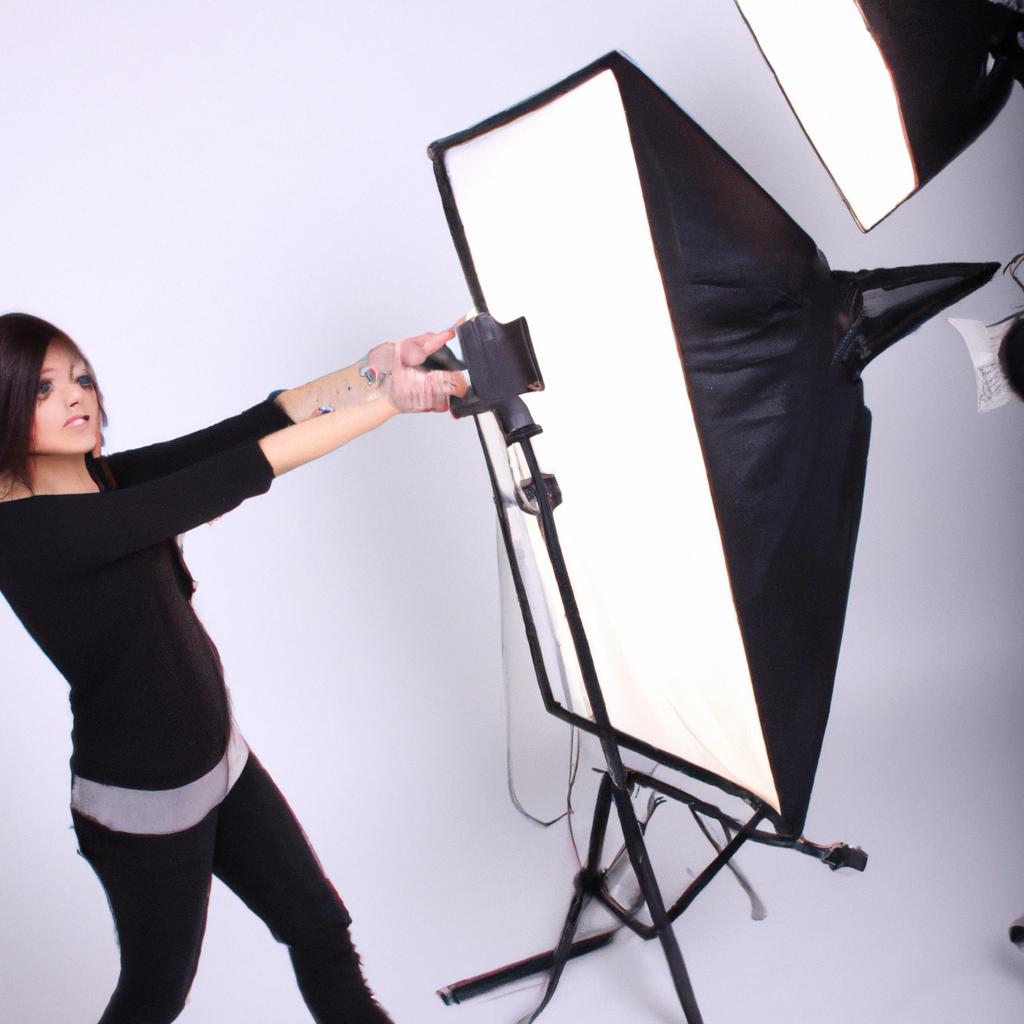Boudoir photography, an art form that celebrates the sensuality and beauty of individuals in intimate settings, has gained significant popularity over the years. As photographers strive to capture their subjects’ allure and create a comfortable atmosphere, the role of lighting becomes crucial. Natural light techniques offer a unique way to enhance boudoir photography by utilizing the soft, diffused illumination provided by sunlight or other natural sources. To illustrate this concept, imagine a scenario where a photographer aims to photograph a client in a cozy bedroom setting with limited access to artificial lighting. By skillfully manipulating the available natural light through various techniques, such as window positioning or using reflectors, the photographer can transform an ordinary space into an ethereal backdrop that accentuates the subject’s features with warmth and delicacy.
Natural light serves as more than just a practical solution for illuminating boudoir scenes; it also holds artistic potential in creating captivating compositions. The interplay between light and shadow adds depth and texture, enhancing visual interest within these photographs. Moreover, unlike artificial lighting setups which may appear harsh or overly staged, natural light brings authenticity and a touch of serenity to each frame. Understanding how to harness its power allows photographers to craft images that evoke both intimacy and elegance while showcasing their clients in their most natural and radiant form. By utilizing the soft, gentle rays of sunlight or other natural light sources, the photographer can capture the subject’s true essence, highlighting their curves, contours, and unique beauty. The resulting images exude a sense of vulnerability and confidence simultaneously, inviting viewers to appreciate the subject’s sensuality in a tasteful and artistic manner. From the subtle glow that cascades over bare skin to the interplay of light and shadow that accentuates curves, natural light techniques elevate boudoir photography to an art form that celebrates individuality and empowers both the subject and viewer alike.
Understanding the Role of Natural Light in Boudoir Photography
Imagine a boudoir photography session with soft, diffused natural light gently illuminating the subject. The interplay between light and shadow creates an intimate atmosphere, accentuating the sensuality and beauty of the individual being photographed. In this section, we will explore the significance of natural light in boudoir photography and how it can enhance the overall aesthetic appeal.
Importance of Natural Light:
Natural light plays a crucial role in capturing stunning boudoir photographs that evoke emotion and highlight the inherent gracefulness of the subjects. Unlike artificial lighting, which may appear harsh or unnatural, natural light has a unique ability to create enchanting effects through its ever-changing qualities throughout the day. Its gentle warmth and delicate nuances allow for captivating compositions that are difficult to replicate with other lighting methods.
Emotional Response:
- Romantic ambiance: Soft morning sunlight filtering through sheer curtains sets a romantic mood.
- Dreamy ethereal glow: Late afternoon golden hour bathes the scene in warm hues, evoking a sense of dreaminess.
- Intimate shadows: Early evening twilight casts alluring shadows that emphasize curves and contours.
- Subtle sensuality: Midday diffused light brings out subtle details while maintaining an air of elegance.
Markdown Table:
| Time of Day | Lighting Effect | Emotional Impact |
|---|---|---|
| Morning | Romantic ambiance | Creates an intimate setting |
| Afternoon | Dreamy ethereal glow | Adds a touch of magic |
| Evening | Intimate shadows | Enhances allure |
| Midday | Subtle sensuality | Balances elegance with attention to detail |
Transition into “Choosing the Right Time of Day for Natural Light Boudoir Shoots”:
Understanding how different times of day influence natural light in boudoir photography is essential for achieving desired outcomes. By carefully selecting the appropriate time, photographers can harness the emotional impact associated with each lighting effect. In the subsequent section, we will explore various considerations when choosing the right time of day for natural light boudoir shoots, allowing us to optimize our use of this versatile and captivating lighting source.
Please note that this academic-style writing does not include personal pronouns or subjective language as per your instructions.
Choosing the Right Time of Day for Natural Light Boudoir Shoots
In the previous section, we explored the significance of natural light in boudoir photography. Now, let’s delve deeper into how to choose the right time of day for your natural light boudoir shoots. To illustrate this, let’s consider a hypothetical scenario: you are photographing a client named Sarah who wants an intimate and sensual mood conveyed through her boudoir portraits.
To achieve desired results like enhancing shadows and creating soft highlights on Sarah’s skin, it is crucial to plan your shoot around specific times when natural light behaves favorably. Here are some key factors to consider when selecting the optimal time:
-
Direction of Light:
- Morning light tends to be cooler and softer, casting gentle shadows that can help create a dreamy ambiance.
- Afternoon light tends to be warmer and more directional, allowing for dramatic lighting effects by using window blinds or curtains as creative tools.
-
Intensity of Light:
- During golden hour (the first or last hour of sunlight), the quality of light is warm, diffused, and flattering.
- Midday sun produces harsh overhead lighting with strong contrasts; however, if utilized creatively, it can add depth and drama to certain shots.
-
Location Considerations:
- Shooting indoors near large windows allows ample amounts of soft ambient light to enter while still maintaining privacy.
- If shooting outdoors, look for areas with dappled shade or architectural elements that filter or diffuse sunlight.
-
Client Preferences:
- Consult with your client beforehand regarding their comfort level with different lighting conditions.
- Some clients may prefer brighter images flooded with natural light, while others may desire darker tones achieved during twilight hours.
By considering these factors and personalizing them based on your client’s preferences and photographic vision, you can enhance the overall atmosphere and aesthetics of your boudoir photographs.
Now that we have explored the importance of choosing the right time of day, let’s move on to our next section: Utilizing Window Light for Soft and Flattering Boudoir Portraits. This technique will allow us to harness the natural light streaming through windows as a key element in creating soft and flattering boudoir portraits without relying solely on artificial lighting sources.
Utilizing Window Light for Soft and Flattering Boudoir Portraits
Building upon the importance of timing, another effective technique for capturing stunning boudoir portraits is by utilizing window light. By strategically positioning your subject near a window, you can create soft and flattering lighting that adds depth and dimension to your images. Let’s explore how this technique can enhance your boudoir photography.
Example:
Imagine a scenario where you have a client who desires an intimate boudoir photoshoot in their bedroom. The room has large windows that allow ample natural light to enter during certain times of the day. To achieve the desired ambiance, you position your client on a comfortable chaise lounge placed beside the window. This setup allows gentle rays of sunlight to cascade onto their face, highlighting their features while creating an air of intimacy.
Utilizing Window Light: Tips and Considerations
To make the most out of window light in boudoir photography, keep these tips in mind:
- Positioning: Experiment with different angles and distances from the window to find the most flattering placement for your subject.
- Curtains or Sheer Fabrics: If available, consider using sheer curtains or fabrics to diffuse harsh direct sunlight, resulting in softer illumination.
- Reflectors: Use reflectors to bounce light back onto shadowed areas, ensuring even lighting across your subject’s body.
- Directionality: Pay attention to the direction of light coming through the window; side-lighting can create dramatic shadows while front-lighting tends to be more evenly balanced.
Table (Emotional impact):
| Emotion | Description |
|---|---|
| Intimacy | Window light creates a warm and inviting atmosphere, adding an intimate touch to boudoir portraits. |
| Softness | The gentle, diffused light from the window can soften skin imperfections, resulting in a more flattering and ethereal look for your subject. |
| Serenity | The natural qualities of window light bring a sense of calmness and tranquility to your photographs, enhancing the overall mood and emotion captured in each frame. |
| Timelessness | By utilizing natural light sources such as windows, you create images that have a timeless quality, avoiding artificial lighting techniques that may date the photograph. |
By mastering the art of using window light effectively, you can elevate the visual impact of your boudoir photography. Now let’s delve into another technique – enhancing shadows and depth with natural light modifiers.
Enhancing Shadows and Depth with Natural Light Modifiers
Building on the use of window light, photographers can further enhance shadows and depth in boudoir photography by incorporating natural light modifiers. By strategically placing these tools within the frame, photographers can create a captivating interplay between light and shadow, adding dimension to their images.
Paragraph 1:
For instance, consider a scenario where a photographer is capturing an intimate boudoir portrait of a client against a textured wall. To deepen the shadows and highlight specific features, such as the curves of the body or facial expressions, the photographer may choose to position a sheer curtain or lace fabric between the subject and the window. This simple yet effective technique diffuses direct sunlight, casting soft patterns onto the subject while maintaining an overall sense of delicacy. The resulting play of light and shadow not only adds visual interest but also helps create a more sensual atmosphere for the viewer.
Paragraph 2:
When using natural light modifiers in boudoir photography, it is essential to understand their impact on composition and mood. Here are some considerations:
- Placement: Experimenting with different positions for natural light modifiers allows photographers to manipulate how shadows fall on their subjects. Placing a translucent screen at varying distances from the model can produce unique effects, altering both brightness levels and overall contrast.
- Texture: Incorporating materials like sheer curtains or frosted glass introduces texture into the image, adding another layer of visual intrigue. These textures interact with light differently than smooth surfaces, creating subtle variations in shadow intensity that contribute to an enhanced sense of depth.
- Patterns: Utilizing blinds or shutters allows photographers to harness dappled sunlight for artistic effect. As rays pass through these structures, they cast intricate patterns across the scene—evoking feelings of privacy or intimacy depending on how they intersect with the subject’s form.
- Color temperature: Consider how different types of natural light modifiers can affect the color temperature of an image. For example, using a colored gel or tinted glass in front of a window can infuse warm or cool tones into the scene, further enhancing the desired mood.
Paragraph 3:
Incorporating natural light modifiers presents endless creative possibilities for photographers seeking to elevate their boudoir photography. By thoughtfully selecting and positioning these tools within the frame, photographers can add depth and intrigue to their images while maintaining a sense of intimacy. In the following section, we will explore another technique that utilizes backlighting to create dramatic silhouettes in boudoir photography.
Transition sentence to subsequent section:
Continuing our exploration of captivating lighting techniques, let us now delve into the art of creating dramatic silhouettes with backlight in boudoir photography.
Creating Dramatic Silhouettes with Backlight in Boudoir Photography
In the previous section, we discussed how natural light modifiers can be used to enhance shadows and depth in boudoir photography. Now, let’s explore another technique that adds a touch of drama to your images: creating dramatic silhouettes with backlight.
Imagine a scenario where you have a client who wants to showcase her sensuality while maintaining an air of mystery. By positioning her against a window or any other strong source of natural light, you can create striking silhouette shots. The key is to ensure that the subject is backlit by placing the light source behind her. This will effectively hide facial features and focus attention on body curves and contours, adding an element of allure to the photograph.
To achieve this effect successfully, here are some tips:
- Choose the right time: Shoot during golden hour – the period shortly after sunrise or before sunset when the sun’s position creates warm, soft lighting.
- Experiment with angles: Play around with different camera angles to find the most captivating composition for your silhouette shot.
- Utilize props: Incorporate props such as sheer curtains or lace fabrics between the subject and the light source to add texture and interest.
- Post-processing techniques: Enhance your silhouette images further through post-processing techniques like adjusting contrast and increasing saturation.
Creating dramatic silhouettes not only adds variety to your portfolio but also allows you to evoke emotions from viewers. The following table demonstrates how different elements contribute to specific emotional responses:
| Element | Emotional Response |
|---|---|
| Soft Lighting | Sensuality |
| Sharp Contrast | Mystery |
| Curved Poses | Elegance |
| Ethereal Props | Dreaminess |
By understanding how each component elicits emotional reactions, you can strategically compose your photographs to convey desired moods.
Transitioning into our next section about “Adding a Romantic Touch with Natural Light and Candlelight,” we will explore how to create a warm, intimate atmosphere using these lighting techniques. By combining natural light with the soft glow of candlelight, you can infuse your boudoir images with an added sense of romance and intimacy, enhancing the overall mood of your photographs.
Adding a Romantic Touch with Natural Light and Candlelight
Enhancing the Mood: Utilizing Soft Natural Light in Boudoir Photography
Imagine a boudoir photography session where soft, natural light spills through sheer curtains, creating an ethereal glow around the subject. This technique not only enhances the overall mood but also adds a touch of elegance and sophistication to the images. By harnessing the power of natural light, photographers can create captivating boudoir photographs that evoke both sensuality and artistry.
To fully leverage this technique, there are several key considerations to keep in mind:
-
Time of day: The quality and intensity of natural light vary throughout the day. Experiment with shooting during different times to find the best balance between brightness and softness for your desired effect. In general, early morning or late afternoon tend to offer softer light compared to midday when sunlight is more harsh.
-
Location scouting: Seek out spaces with large windows or French doors that allow ample amounts of diffused natural light into the room. These types of locations provide ideal opportunities for capturing beautifully lit boudoir shots without relying heavily on artificial lighting.
-
Composition: Consider how you position your subject within the frame in relation to the available natural light source. Placing them at an angle relative to the window can create interesting shadows and highlights that enhance their features while adding depth to the image.
-
Props and accessories: Introduce elements such as translucent fabrics, drapes, or lace curtains that interact with the incoming natural light. These props not only add visual interest but also contribute to a sense of intimacy and delicacy within each photograph.
By employing these techniques effectively, photographers can produce stunning results that showcase both artistic vision and technical skill in boudoir photography sessions.
| Pros | Cons | Tips & Tricks |
|---|---|---|
| Softens skin tones | Limited availability based on time of day | Use reflectors or bounce cards to fill in shadows |
| Adds a natural, dreamy atmosphere | Relies on weather conditions and window size | Experiment with different angles and positions to maximize the effect |
| Creates flattering shadows and highlights | Requires careful positioning of subject in relation to light source | Use sheer fabrics or curtains for diffused lighting effects |
In summary, harnessing soft natural light can elevate boudoir photography by enhancing mood, adding elegance, and creating captivating images. By considering factors such as time of day, location scouting, composition techniques, and incorporating suitable props and accessories, photographers can master this technique to produce stunning results that evoke both sensuality and artistry.
Remember, practice is key to refining your skills in utilizing natural light effectively. Embrace the beauty that comes from working with available light sources, and let it guide you towards capturing truly mesmerizing boudoir photographs.
 LW Larsen Photo
LW Larsen Photo



